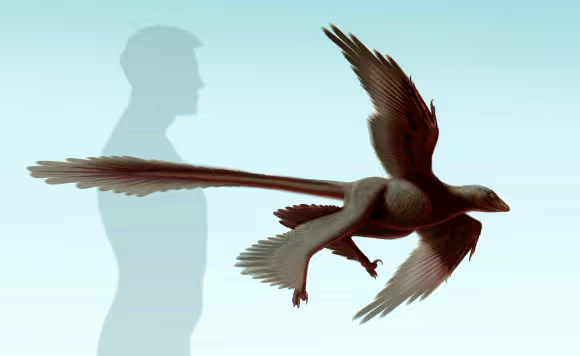Flight, in nature, has been and continues to be, a source of awe for humans. Scientists in particular have been puzzling over the origins of feathered flight for over a century. Did the ancestors of modern birds begin to fly by running along the ground and flapping feathery arms? Or did they primarily live in the trees and occasionally need to jump, arms and legs outstretched?The ability to fly has only evolved in vertebrates (creatures with back bones) three times: the pterosaurs, the chiropterans (bats), and of course, in birds and their ancient relatives. The flightless ancestors of bats were probably very similar to what we recognize as bats today: fuzzy, mammalian, nocturnal insectivores that lived in trees. Scientists are relatively sure that these creatures evolved the ability to fly as the thin flaps of skin between the finger and the ankle became useful to break a fall from a limb and to glide downward from treetops in pursuit of tasty bugs or to escape predators.The first vertebrates to develop flight, the pterosaurs, were also the largest creatures ever to fly. As they have no obvious tree-related adaptations, paleontologists believe that their flightless ancestors ran along the ground in open spaces, developing the flight stroke to catch prey or evade danger. Research by scientists at the University of Montana published in the Journal of Experimental Biology in 2011 suggests that running around flapping wings may actually be an effective way to travel. Their experiment proved that pigeons running up a ladder while flapping their wings burned even less energy than pigeons that flew along the same trajectory to reach the same stopping place. This could mean that the specific arm stroke necessary to flight is useful to ground dwellers, even before it is perfected as a means of flying.So did birds develop flight from the ground-up, like pterosaurs? Or did their flight evolve top-down, like chiropterans? The latest piece of the puzzle is a new dinosaur named Changyuraptor yangi, one of the of many pre-avian feathered dinosaurs called microraptors to be discovered in the Liaoning Province of China.A study published in Nature Communications last July led by Gang Han, of Bohai University in China, describes a four-foot long dinosaur that sported long stiff feathers on its legs as well as its arms and tail. Despite being the heaviest microraptor ever discovered, at approximately nine pounds, Gang Han and associates believe C. yangi may have been able to fly.While being far from a conclusive discovery, C. yangi lends its considerable weight to the top-down theory of feathered flight. With such cumbersome feathers and such prodigious size, it is unlikely C. yangi became airborne by running along the ground. Scientists picture Changyuraptor using its four wings and tail to parachute down from trees. While probably not capable of sustained flight, C. yangi had five feathered limbs which would have produced drag and made for a soft landing after short glides.It is possible that Changyuraptor evolved feathered flight completely independently of birds. Birds had been in existence for approximately 25 million years before Changyuraptor. However, 25 million years is a short enough time frame to indicate that microraptors like C. yangi and birds probably inherited flight from the same common ancestor.




